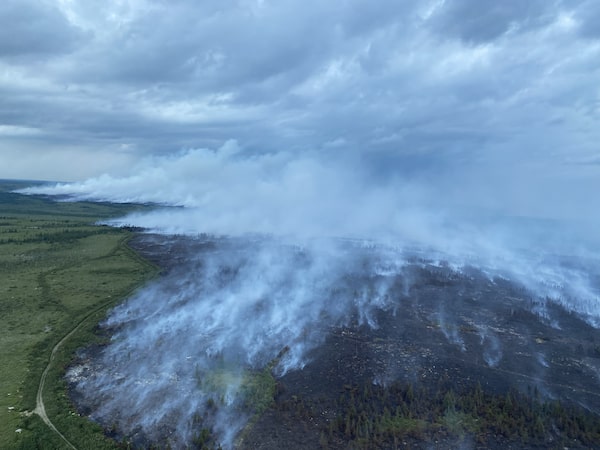
Smoke from a forest fire in central Newfoundland on Aug. 7.The Canadian Press
The worst forest fires to hit Newfoundland and Labrador in more than 60 years have stranded hundreds of travellers who had returned to the island’s south coast for a series of summer festivals and reunions, while officials scramble to airlift food to communities cut off by the massive blaze.
People who live in more than a dozen small communities on Newfoundland’s south cost have been stuck there since last week, when wildfires once again forced the closing of the Bay d’Espoir Highway – the remote, heavily wooded artery that’s the only road link to the rest of the province.
Travellers trying to leave the area are abandoning their vehicles and crowding onto ferries that have been overwhelmed with lineups of people hoping to get out.
Many of those stranded in these small communities had travelled for Come Home Year celebrations, a series of civic events and concerts that encouraged Newfoundlanders living off the island to return for reunions.
In Harbour Breton, a community of about 1,600, more than 300 people who had come to town for a Saturday concert as part of those festivities were left stuck by the wildfires. The concert’s headline act still performed its show, but had to be brought in on a fishing vessel because the road into town was impassable.
The future of wildfires in Canada
In a part of the province where some isolated outports still rely on a network of small ferry boats as a crucial transportation link, the fires and highway closings have created a logistical nightmare.
“You can imagine the chaos that’s starting. I had 140 people message me this morning, saying they needed to get out,” said Steven Crewe, mayor of Hermitage-Sandyville, a town of about 400 people on Newfoundland’s south coast.
“I just told them to go line up for the ferry and hopefully you’re one of the lucky ones who’s able to get on.”
The fires are affecting a huge swath of central Newfoundland, where on Sunday a state of emergency that already included areas around Grand Falls-Windsor, Bishop’s Falls and the Connaigre Peninsula was extended as the flames spread further out of control. The blazes are the largest in Newfoundland since 1961, Premier Andrew Furey said.
Mr. Crewe said he’s trying to co-ordinate an emergency helicopter shipment, planned for Tuesday, of basic food items such as baby formula, milk and bread. The deputy mayor of Harbour Breton said his community’s three grocery stores will be out of food within the next day or two.
Roy Drake owns one of those stores and already, there’s not a jug of milk or a loaf of bread left on any of his shelves, he said.
“Things are starting to get stressful for most residents,” Mr. Drake said in a phone interview from the town hall. “We need to get food in within a day or so to help us out. Not just for Harbour Breton, but for the entire region.”
Health officials, meanwhile, were removing cancer patients by helicopter and boat, and are evacuating others to a hospital in Gander. Pregnant women were being told to avoid the hospital in Grand Falls-Windsor, where staff said they can’t turn air conditioning on because of thick smoke.
An emergency shelter that had been set up to house stranded travellers in Grand Falls had to be relocated to Deer Lake, more than 200 kilometres to the west, as the fires have grown. While no evacuation order had been given by Monday morning, buses were being organized to carry people concerned about air quality out of affected areas to Deer Lake.
On the south shore, where salmon farming is a major employer, aquaculture companies are shipping massive loads of fish food, a crucial supply normally carried every day by a fleet of transport trucks, on boats as the highway remains closed.
“We’ve only got one way in, and one way out,” Mr. Crewe said. “This situation proves that we’ve got to get another route here, I don’t care what it takes. This affects everything, from medical appointments and surgeries to food and jobs. ”
The fires started consuming tracts of forest around the Bay d’Espoir Highway after a lightning strike on July 24, during one of the hottest and driest summers in memory in central Newfoundland. As of Sunday, the provincial government reported four active fires covering about 10,800 hectares.
Firefighting crews were working around the clock, bulldozing wide buffers along hydro routes, trying to create fire breaks to slow the blazes down. Water bombers, including planes sent from Quebec, continued to attack the fires from above. Canadian Forces soldiers, along with staff from multiple federal agencies, were helping to co-ordinate evacuation plans.
The Premier said changing wind patterns were making the situation difficult to handle, but so far the blazes hadn’t reached any communities. Rain was in the forecast for Tuesday, but it was unclear how much precipitation would reach the most affected areas.
At a news conference Sunday alongside Fisheries, Forestry and Agriculture Minister Derrick Bragg and Department of Natural Resources Incident Commander Craig Coady, Mr. Furey said conditions had changed rapidly over 36 hours, and they were concerned about significant smoke impact.
Mr. Coady said the wildfires will most likely continue to burn out of control because of the dry, windy conditions that have complicate firefighting efforts.
With a report from The Canadian Press
Our Morning Update and Evening Update newsletters are written by Globe editors, giving you a concise summary of the day’s most important headlines. Sign up today.
 Greg Mercer
Greg Mercer